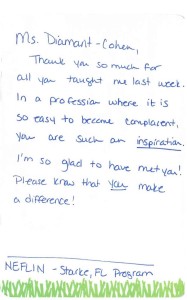During the past two weeks, I have been watching a newly released video series called “The Raising of America.” In addition to giving updated facts and research regarding the importance of the earliest years in children’s lives, this series presents historical information regarding childcare in the US that I had not previously known.
During World War II, a national network of child development centers throughout the US was funded by the Lanham Act. While mothers worked in factories replacing male factory workers who were at war, the government provided free childcare for 600,000 children. However, when the war ended, the women were expected to return home and the childcare centers closed.
By 1970, about 50% of women in the US were again part of the US workforce. Senator Walter Mondale introduced a bill called the Comprehensive Child Development Act (CCDA), written with Marian Wright Edelman from the Children’s Defense Fund. Modeled after Head Start, the CCDA aimed to make the US government responsible for providing “high-quality childcare and early education, home visiting and other services to each and every family that wanted it.” The CCDA was passed in Congress with bi-partisan support from both Democrats and Republicans. It sought to promote both social equality and national prosperity.
Richard Nixon mentioned the importance of early childhood in a speech at the White House Conference on Children in 1970. He claimed that his “absolute number one priority … was good quality, affordable child care,” and that he supported universal childcare. When the CCDA was passed, in order for it to become law it needed to be signed by President Nixon. Sounds simple, right?
Pat Buchanon had President Nixon’s ear. Backed by the Conservative Movement, he painted the bill as a “communal approach” to child-rearing, equating it with “Sovietization” of American Children. Phyllis Schlafely, founder of the Eagle Forum and staunch anti-feminist, launched a campaign equating childcare as “against family values.” According to Schlafely, a woman should be at home raising her children and not out working.CCDA opponents claimed that government programs that could help poor or working famlies would undercut “personal responsibility.” Ignoring the fact that a large number of women needed to work to support their families, and thus need childcare in order to leave the home to work, “family values” were “invoked to undermine initiatives intended to help families.” The Conservatives put pressure on Nixon. Nixon caved in and vetoed the bill.
Since then, lower and middle class mothers who need to work struggle to find high-quality childcare that they can afford. Some families pay more monthly fees for childcare than they do for rent! If parents can’t pay for childcare, then they have to either stay at home, or leave their child is substandard care that is affordable. The earliest years are the ones that form the social, emotional, and cognitive framework for children; not having adequate childcare can severely limit possibilities for development of important skills and experiences.
In each of the five segments, narrators referred to research regarding the formation of the brain’s architecture in the earliest years of life. They mentioned the detrimental effect constant stress can have upon the development of children’s brains, explaining how heightened levels of cortisol can permanently change the underlying structure. The need for children to have to have more than simply “custodial care”, to have social experiences and intellectual stimulation in addition to being fed and having diapers changed, makes a huge difference in their development.
The CCDA bill was re-introduced twice in Congress following the 1971 veto. Phyllis Schlafly again went into action, writing a newspaper editorial that stated: “We are told that the Mondale-Brademas bill will strengthen the family, whereas it will actually do the opposite because it will relieve parents of their responsibility for child rearing. Anyone who wants to strengthen the family should encourage mothers to stay home and care for their own preschool children.”(Observer-Reporter, August 3, 1976, A-4). Again, the bill was not put into action
After watching all five segments of the series, I could help but imagine what our county would be like right now if the CCDA had passed. If all families had access to free high-quality childcare, children would be nurtured from the very start, mothers would be able to help support their families financially without worrying, and childcare providers would be operating within a governmental framework that would require certification but also pay a decent wage. Rates of poverty in the US would be much lower, children would start with much better advantages, and the possibilities for advancement for families from all economic and racial backgrounds would be greatly increased.
I wonder if President Nixon realized the damage his veto would cause?
According to “The Raising of America,” the US has the least the lowest amount of childcare support than these other nations: Austria, Canada, Denmark, Finland, France, Germany, Italy, Norway, Sweden, and the United Kingdom. Childcare facilities are inspected less than prisons . According to the U.S. Bureau of Labor Statistics, many childcare workers are paid a wage that is “lower than the poverty level income for a family of three.”
To find out more, visit The Raising of America Website; there are some incredible resources as well as transcripts and guides for leading discussion after viewing each of the segments.
What can we do to bring back the a bill to support universal childcare in the US?



